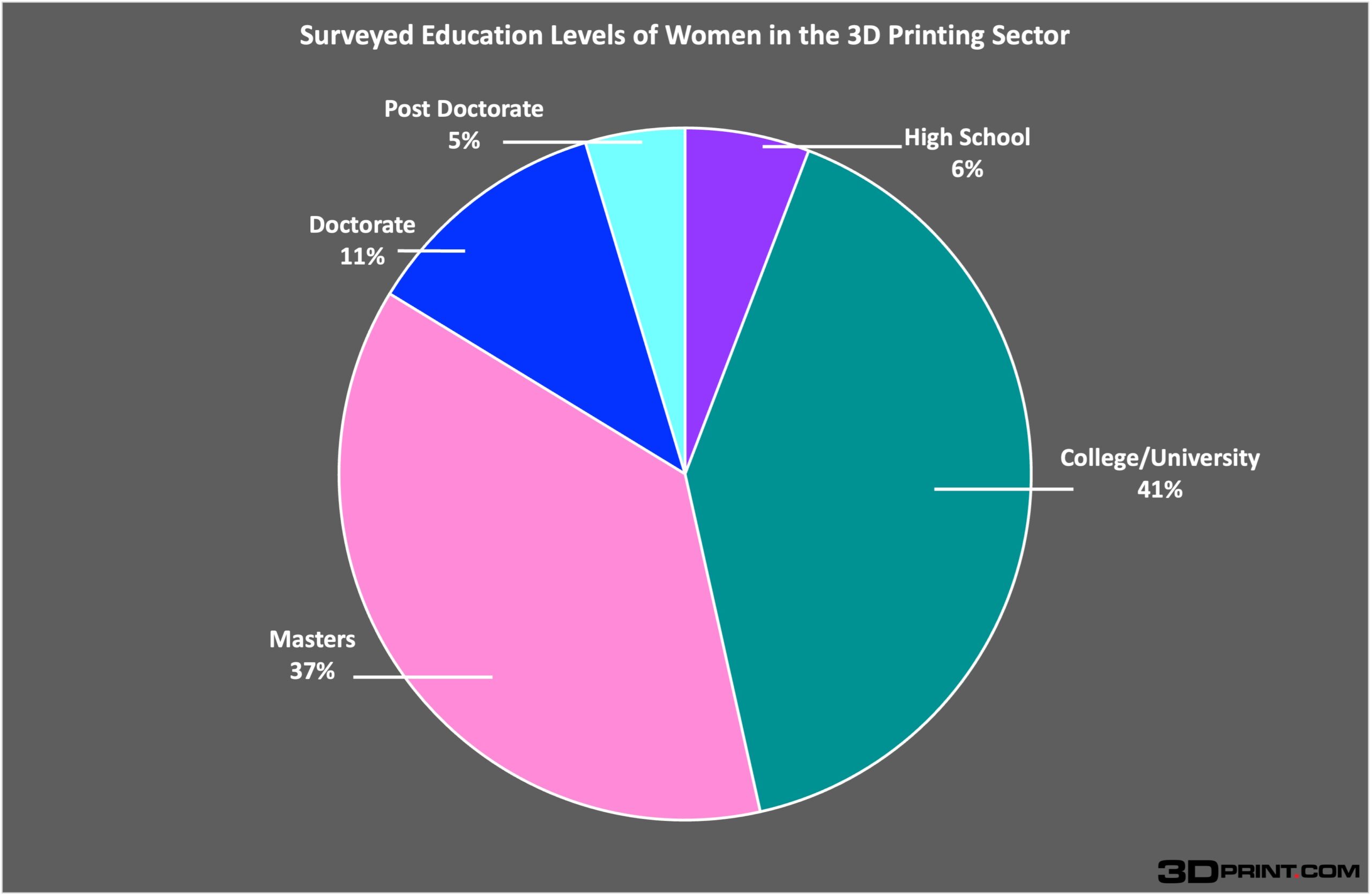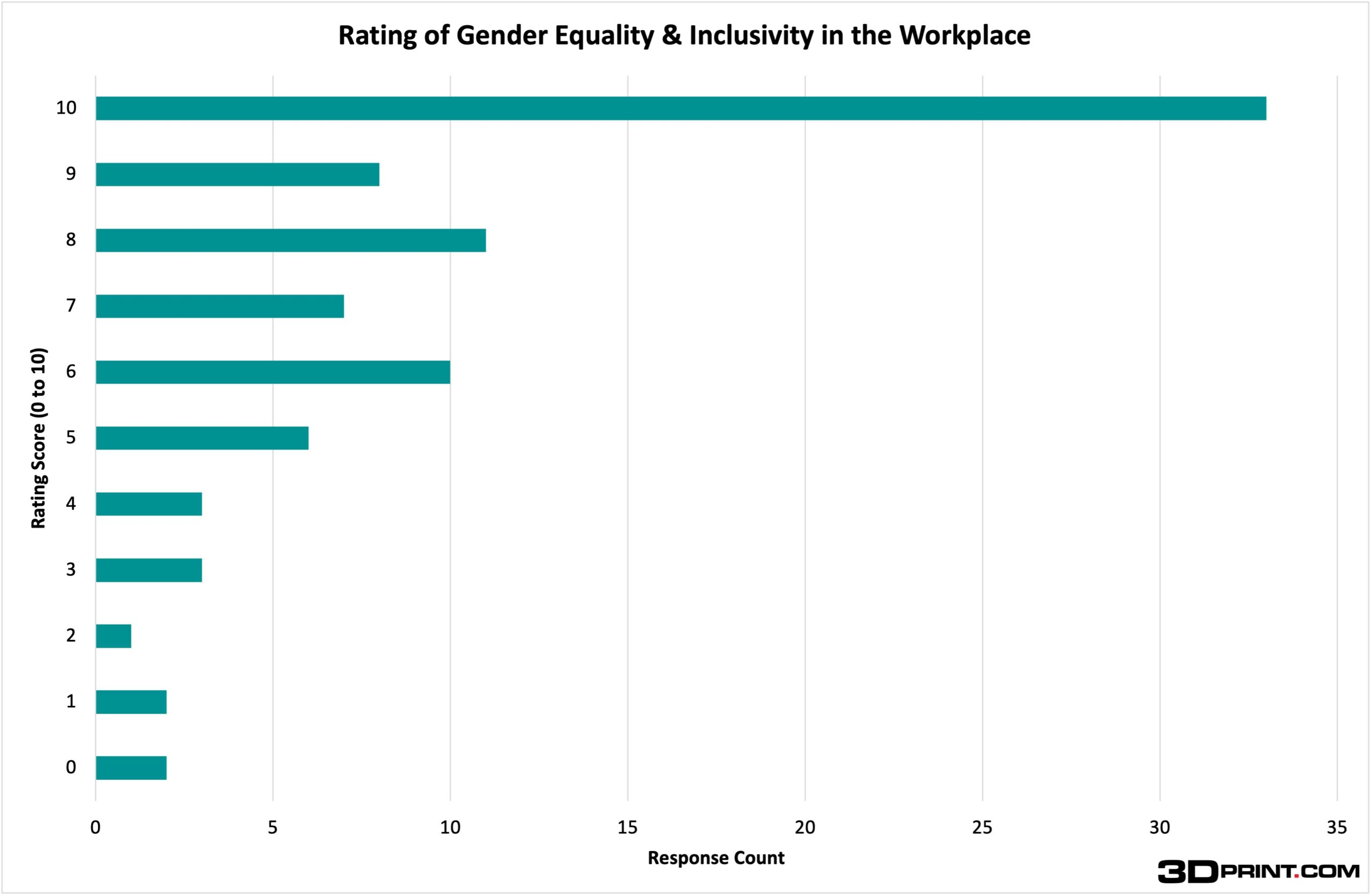In early June, 3DPrint.com launched a survey to gauge how women have been navigating and influencing the dynamic 3D printing sector. In this article, we break down some of the findings that we uncovered.
A remarkable 58% of the participants held executive management roles, such as CEO and Founder, showcasing the prominence of women’s leadership in the industry. With 83% pursuing higher education, the 3D printing sector boasts a highly educated workforce, paving the way for growth and innovation. The educational backgrounds of the respondents further bolster this narrative; of this majority, 41% completed college or university careers, 37% achieved a master’s degree, and 17% advanced to doctorate or post-doctorate levels (as shown in Graph 1 below). These academic credentials are essential for an industry that thrives on technical advancements and innovative solutions.
Graph 1: Surveyed Education Levels of Women in the 3D Printing Sector
Another key finding from the survey highlights that 55% of women transitioned from other fields. With 28% of these professionals hailing from engineering and manufacturing, 17% from product development and design, 13% from healthcare and biomedical sectors, and 6% from technology, the industry benefits from a wealth of experience. Moreover, 38% brought insights from chemistry, polymer science, art, and design.
Such strong academic credentials and the rich tapestry of professional backgrounds serve as strategic assets for an industry that thrives on technical advancements and innovative solutions. The journey of these women into 3D printing reveals interesting trends: while 45% targeted the sector intentionally, 55% transitioned from other fields. Going further, of those drawn explicitly to 3D printing, an impressive 67% found jobs within just two years after finishing school. These findings highlight the sector’s attractiveness and position 3D printing as a promising career choice for women after their studies.
Workplace dynamics
Regarding colleagues, 66% of women reported having between 1 to 10 female colleagues in their workplace, with 16% working in environments devoid of other women. At the top end, 6% work alongside 21 to 40 female peers, and another 6% are in settings with more than 40 women, a trend particularly noted among those from some of the bigger companies in the industry, like Materialise and Stratasys.
As for career progression, the majority (66%) ascended to their current roles within just a year. However, while many women experience rapid progression, a notable 17% took over five years to reach their status. This longer journey often reflects those transitioning from other sectors, indicating a mix of rapid advancements and lengthy transitions within the 3D printing industry.
An essential metric for understanding workplace dynamics is gauging perceptions of gender equality and inclusivity. At least 38% rated their workplaces with perfect scores for gender equality and inclusivity (as shown in Graph 2 below). Still, 20% found considerable room for improvement. Although 68% felt gender disparities were non-existent in career advancement, nearly half acknowledged facing unique challenges as women in the industry.
Graph 2: Rating of Gender Equality & Inclusivity in the 3D Printing Workplace
Voices from the field
Beyond statistics, it’s vital to recognize women’s lived experiences in the 3D printing industry – these range from clear bias to subtle workplace behaviors that doubt their skills. Instances of being overshadowed in industry discussions and facing assumptions about their competency were prevalent. Some recounted confronting blatant sexual harassment, while others grappled with implicit biases that trashed their contributions.
Internationally, awareness of gender inequality varies. While the US may be more conscious of the issue, the global scale of the 3D printing industry means that not all regions uphold the same standards of gender equality. It’s alarming that 31% have experienced or witnessed gender-based discrimination in their workplaces, suggesting that while progress has been made, plenty of work is still ahead in ensuring a level playing field.
Layers of equality
In the 3D printing industry, company efforts towards diversity and inclusion vary largely. While around a quarter implemented flexible work policies, a similar proportion lacked any inclusivity initiatives. Other inclusivity measures, such as inclusive recruitment and hiring practices, employee feedback mechanisms, leadership development programs, and diversity training, appear less prevalent, each implemented by around 10% of the represented companies. Participants strongly supported mentorship programs to help improve gender equality in the industry. They also suggested getting students involved early on, offering equal parental leave for both genders and avoiding language that favors one gender over another.
While a majority feel at ease expressing their views regardless of their gender, it’s concerning that many still feel their gender influences professional perceptions and treatments directed towards them. This sentiment is echoed by the fact that over 40% of participants believe their gender has shaped how they are perceived and treated in their workplaces.
Salary insights revealed an interesting trend, especially for leadership roles, with 30% reporting an annual income exceeding $100,000. Most earn a good salary, above $70,000. However, a smaller segment, comprising about 9%, indicated earnings below $50,000. This data sheds light on the promising earning potential for women, especially those aiming for leadership positions in the 3D printing sector.
In June 2023, 3DPrint.com thoroughly analyzed over 670 companies in the 3D printing sector to assess female representation in leadership roles. Much like this, the previous study revealed encouraging progress toward gender diversity, with over 1,220 women occupying significant positions, including CEOs, board chairs, and founders. Specifically, 108 women serve as CEOs, 86 chair boards, and 115 are company founders. While these numbers show improvements, they also highlight an existing gender gap, emphasizing the need for continued efforts to bolster female leadership in the industry.
In summary, the survey offers a glimpse into women’s strides and areas where more progress is needed. Many female professionals hold leadership roles and benefit from competitive salaries, painting a hopeful picture for the future. However, biases and clear cases of unfair treatment still exist, indicating a need for further reflection and action. More comprehensive data, surveys, and studies are required to truly understand the depth and implications of women’s experiences in 3D printing. As the industry grows and changes, it’s essential to treat everyone fairly, regardless of gender. Using the skills and ideas of women is not only the right thing to do but also helps make better products. We must make changes now so that women can do well in this field and have the same chances as men.
Subscribe to Our Email Newsletter
Stay up-to-date on all the latest news from the 3D printing industry and receive information and offers from third party vendors.
Print Services
Upload your 3D Models and get them printed quickly and efficiently.
You May Also Like
Johns Hopkins University Researchers Develop HyFAM Technology
Two scientists from Johns Hopkins University, Nathan C. Brown and Jochen Mueller, have developed a hybrid manufacturing technology they call HyFam, or Hybrid Formative Additive Manufacturing. Their work on this technology...
3D Printing G-Code Gets an Upgrade: T-Code
Good old G-Code still manages many 3D printers, great and small. Just like the STL, it’s a standard that enables collaboration while also holding the additive manufacturing (AM) industry back....
AM Rewind: The Biggest News and Trends of 2024
After a sluggish 2023, driven by persistent inflation and geopolitical tensions, 2024 has seen some recovery. Economic growth climbed from about 2.8 percent in 2023 to a modest 3.2 percent...
Metal Wire 3D Printer OEM ValCUN Announces Plans for 2025 Expansion
ValCUN, a Belgian original equipment manufacturer (OEM) of wire-based metal additive manufacturing (AM) hardware, has announced that the company has entered the next phase of its growth trajectory, making key...



































